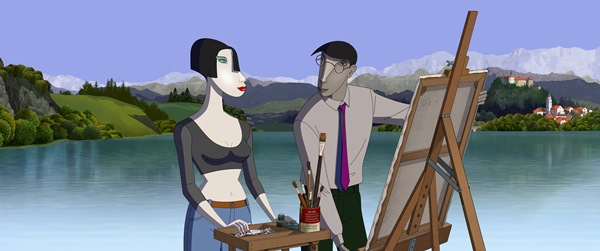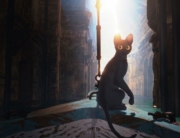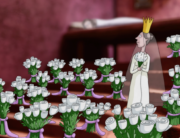This stylish and surreal animated film is driven by the neuroses of Ruben Brandt (voiced by Iván Kamarás), an extremely wealthy art-therapist who encourages his patients to create artworks that explore their trials and traumas, thereby giving them mastery over their demons. Yet he is beset by nightmares and visions in which figures from different paintings attempt to murder him in bizarre ways; for instance, he is challenged to a shootout by the cowboys from Andy Warhol’s Double Elvis; Botticelli’s Venus brings him under the ocean and morphs into a bloodthirsty Ursula the Sea Witch; he is pursued by a similarly feral iteration of the Infanta from Velásquez’s Las Meninas. His patients conspire to steal the artworks that have been haunting him, thereby giving him master over his demons. The plot concerns their effort to do so, as well as the detective and mobsters who are involved in chasing them.
The film is nothing if not playful. Chase sequences filled with acrobatics, improbable escapes, and playful lines of dialogue between the pursuer and the chased occur more than once, and one feels the filmmaker relishing in the fun of it all, shamelessly indulging in clichés almost as though to celebrate them. Sometimes the backgrounds are full of movement, but very often they are alarmingly still, as though the action were taking place across the canvas of a painting. Indeed, on several occasions the backgrounds are taken straight out of Manet and Picasso, and often the characters’ faces are similarly an homage to famous paintings. Many people have several eyes, noses, or bizarrely shaped ears, and none of it is ever commented on. Each character is deliberately eccentric, and one senses that director Milorad Krstic has delighted in filling his film with them and is as taken with the artworks featured in the film as Ruben is plagued by them.
This film will doubtless entertain many viewers and not ask much of them. Though it is made with enthusiasm and care, the material is curiously thin. It is not a movie that aspires to realism in any way, and yet the characters still don’t feel real enough to give them any weight given that the film revels too deeply in clichés. Mimi (Gabriella Hamori), for instance, Ruben’s seductive, slippery patient who has a weakness for thievery, is so skin deep that we are not as entranced or amused by her quips and tricks as the film expects us to be. This is true for most of the female characters.
Even though we are aware of the stakes for Ruben, the entire plot seemed to be of very little consequence. The constant references to works and the world of art are entertaining but ultimately a little too cute. It is possible that the director chose to juggle too many different characters and plotlines to give any individual one the heft that it deserved, for it is remarkably easy to lose focus in this film, not so much because of its complexity but because no one thread feels full enough to hold our attention. Luckily, the plot is absurdly easy to follow.
That being said, Krstic is clearly a director who knows how to have fun. Die-hard animation fans will certainly want to see this film for its unique visual style, and certainly many viewers will be swept away by the director’s sense of humor and the film’s quick pace.







Leave A Comment